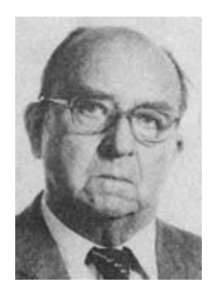Géza Bognár
He earned a degree in mechanical engineering from the József Nádor University of Technology and Economics in 1937.
In 1938, he became a development engineer at the Budapest Postal Experimental Station, and then worked as a department head at the institute until 1950.
In 1950, he was appointed deputy director of the Telecommunications Research Institute ( TKI ), and was the institute's scientific director from 1970 to 1976. He retired in 1977.
In parallel with his research work, he also taught at the Budapest University of Technology ( BME ) as a visiting lecturer.
At the beginning of his career, he worked on radio measuring instruments. In the 1940s, he and his colleagues developed a remote-viewing receiver (television) and a radar locator for demonstration purposes, and summarized the possible methods of radar design. Through the practical application of his high-frequency measurement results, he contributed to the reconstruction and development of domestic radio facilities after World War II.
In later years, he focused on the design and development of communication systems based on microwave data transmission, and of guided microwave radio links. Together with Gedeon Willoner, he created the theoretical foundations of time-division multichannel – i.e. microwave radio links capable of transmitting multiple pieces of information simultaneously on a single channel. He dealt with such details of microwave telecommunications systems as, for example, the theoretical possibilities of increasing their information capacity. He successfully developed a multichannel transmission system; his colleagues designed microwave radio equipment operating in the 4, 6, 8 GHz frequency range under his supervision.
During his career, he published university notes and numerous professional articles, and also participated in the editing of the journal Problems of Control and Information Theory, published by the Hungarian and Soviet Academies of Sciences from 1972.
In 1949, he was elected a corresponding member of the Hungarian Academy of Sciences (MTA), and in 1958, a full member. Between 1956 and 1960, he was the secretary of the scientific body, between 1960 and 1964, its deputy secretary general, and between 1973 and 1976, its vice president. From 1964 to 1970, he served as secretary of the Department of Technical Sciences, and from 1970 to 1973, he served as president. He also participated in the work of the MTA's International Relations and Telecommunications Systems Committees. In 1980, he was elected an external member of the Polish Academy of Sciences.
He took part in the work of several other domestic scientific and science policy bodies. Thus, from 1962 until his death, he was a member and then a member of the presidency of the National Technical Development Committee (OMFB) and the Council for Science and Higher Education. From 1966 until his death, he held the position of chairman of the Hungarian national committee of the International Radio Science Union (URSI), but he was also a member of the national committee of the International Council of Scientific Unions (ICSU), the Technical Research Coordinating Council, and the presidency of the Telecommunication Scientific Association (HTE).
His awards: Kossuth Prize twice, shared the second time with Gedeon Willoner (Hungarian state, 1949, 1956); Bronze degree of the Order of Merit for Labor (1948); Silver degree (1950); Order of Merit for Labor (1958, 1960); Gold degree of the Order of Merit for Labor (1969); Liberation Jubilee Commemorative Medal (1970); Tivadar Puskás Prize (HTE, 1971 and 1975); Second degree of the Order of the Flag of the Hungarian People's Republic (Hungarian state, 1975); Academic Gold Medal (MTA, 1976); Order of Merit for Socialist Hungary (Hungarian state, 1979).
Created: 2024.06.04. 16:08
Last modified: 2024.06.06. 15:28

